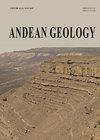阿根廷Neuquén Caviahue湖天然酸性沉积物中微量金属的分配和潜在移动性
IF 1.2
4区 地球科学
Q3 GEOLOGY
引用次数: 3
摘要
由于火山流体的涌入,位于巴塔哥尼亚(阿根廷)的Caviahue湖是一个非常酸性的水体(阿根廷巴塔哥尼亚)。在过去的18年里,该湖一直在逐渐碱化,pH值接近三价铁沉淀阈值(pH>3.0)。如果铁沉淀,水和沉积物成分将发生变化。为了设定基线,使用顺序提取程序(SEP)和酸性挥发性硫化物/同时提取金属(AVS/SEM)方案,在三个采样站研究了三个沉积物岩芯(0至16cm深)的微量金属分配(Cu、Cd、Cr、Pb、Zn和Mn)。沉积物中的总金属含量在0~408μg~(-1)之间,其中Pb>Cr>Mn>Cu>Zn>Cd。未测得镉含量超过检测限。沉积物中Mn和Cr含量最丰富,这两种无毒金属在湖盆的pH/Eh组合下。总Pb处于中等污染水平,尽管它与最难降解的部分有关,因此具有低迁移率。金属含量较高的沉积物组分是可氧化的和残余的,前者通常与不稳定有机物和黄铁矿有关,而后者与难降解有机物和成岩矿物有关。此外,发现Cr、Pb和Mn之间存在高度相关性,因此这些金属可能会经历类似的沉淀过程,并可能在火山流出物中发生共同变化。此外,在所有沉积物组分中最不稳定的可交换/碳酸盐组分中未检测到金属。(SEM)中的金属含量同样低于两个国际沉积物质量指南的毒性阈值,AVS/SEM比值超过1,表明无毒。这两个结果都表明,Caviahue湖酸性沉积物中的金属迁移率很低。本文章由计算机程序翻译,如有差异,请以英文原文为准。
Trace metal partitioning and potential mobility in the naturally acidic sediment of Lake Caviahue, Neuquén, Argentina
Lake Caviahue, in Patagonia (Argentina), is a very acid water body (Patagonia, Argentina) due to the influx of volcanic fluids. Over the past 18 years, the lake has been progressively alkalinizing and pH is close to the ferric iron precipitation threshold (pH>3,0). Should iron precipitate, water and sediment composition will be altered. To set a baseline, trace metal partitioning (Cu, Cd, Cr, Pb, Zn and Mn) was studied for three sediment cores (0 to 16 cm depth) at three sampling stations using a sequential extraction procedure (SEP) and the acid volatile sulfide/simultaneously extracted metals (AVS/SEM) protocol. The total metals content of the sediments ranged between 0 to 408 μg g-1 of dry sediment, with Pb>Cr>Mn>Cu>Zn>Cd. No Cd was measured above the limit of detection. The sediment was richest in Mn and Cr, two non-toxic metals at the pH / Eh combination of the lake basin. Total Pb was at a moderate contamination level although it is associated with the most recalcitrant fraction and therefore has low mobility. The sediment fractions with higher metal content were the oxidizable and residual, the former commonly associated with labile organic matter and pyrite while the latter are related to recalcitrant organic matter and rock forming minerals. In addition, a high correlation was found between Cr, Pb and Mn,thus these metals may be subject to analogous precipitation processes and possibly to co-variation in the volcano effluents. Furthermore, no metals were detected in the exchangeable/carbonates fraction, which is the most labile of all the sediment fractions. The metal content in (SEM) was likewise below the toxicity thresholds of two international sediment quality guidelines and the ratio AVS/SEM was over one, indicative of non-toxicity. Both results indicate that metal mobility in the acidic sediments of lake Caviahue is very low.
求助全文
通过发布文献求助,成功后即可免费获取论文全文。
去求助
来源期刊

Andean Geology
地学-地质学
CiteScore
3.90
自引率
0.00%
发文量
17
审稿时长
>12 weeks
期刊介绍:
This journal publishes original and review articles on geology and related sciences, in Spanish or English, in three issues a year (January, May and September). Articles or notes on major topics of broad interest in Earth Sciences dealing with the geology of South and Central America and Antarctica, and particularly of the Andes, are welcomed.
The journal is interested in publishing thematic sets of papers and accepts articles dealing with systematic Paleontology only if their main focus is the chronostratigraphical, paleoecological and/or paleogeographical importance of the taxa described therein.
 求助内容:
求助内容: 应助结果提醒方式:
应助结果提醒方式:


